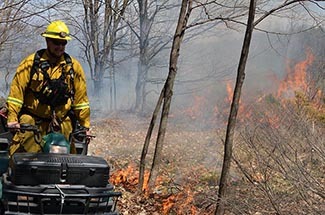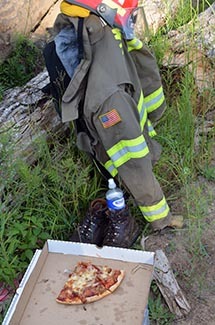Behind the DNR's firefighting front lines
By JOHN PEPIN
Michigan Department of Natural Resources

Did you ever drive through a beautiful Michigan forest, admiring the stately white birches, the colorful maples or the towering pines, and wonder who protects these places in the event of a wildfire?
Sure, it’s firefighters, but who are they, exactly?
What about the birds, the deer, the wildflowers and ferns and other plants and wild creatures? Or the moms and dads, kids and grandkids, brothers and sisters and their camps and houses, places they live and play?
Who steps up with a fire tool and a helping hand to aid these among us when flames and smoke cover the countryside?
At the Michigan Department of Natural Resources, it’s firefighters who represent a wide range of people from across several DNR divisions and disciplines.
These firefighters have undergone training and fitness testing, and they report to the Fire Section, within the DNR’s Forest Resources Division.
For the DNR team, firefighting is merely a part of the work duties they perform.
Though pressed by deadlines, countless tasks and a short supply of extra time, these DNR coworkers lend some of their much-needed talents to the cause of saving lives and protecting property and natural resources.
Some of these firefighting men and women are members of Michigan’s four incident management teams, often referred to as “short teams.” These teams get help battling blazes from local volunteer fire departments and, in cases of large fires, equipment and personnel from other states or provinces.
|

DNR staffers who respond to the challenge of firefighting bring diverse talents to bear in exchange for a rewarding opportunity to personally contribute to a greater good.
Leadership and logistics
Rich Ahnen is a fire supervisor from the Crystal Falls Management Unit who has served on a short team in the Upper Peninsula since 1999. He has worked as incident commander on nine events.
“One of the biggest things that keeps me interested in being on an incident management team is the fact that every incident has its differences. There are no two alike, so I learn something from each one,” Ahnen said. “It is a challenge to be involved in stressful situations, I feel — but a very positive thing for me.”
Rose Wilbur is on the east Upper Peninsula short team, serving as a logistics section chief. That is a behind-the-scenes position, with many functions that work to support the team.
“One of the main priorities is to ensure that the people working on the incident have housing, water and meals,” Wilbur said. “This requires a great deal of coordination and preplanning.”
Logistics is also responsible for the equipment in the fire cache trailer, filling resource requests, determining base camp setup, helping to appropriately stage equipment and supervising team communications.
|

For larger incidents (mostly those that require out-of-state duty), the logistics section chief oversees base camp crews, food supply leaders and other support positions.
“Ensuring that the team and the fire crews have substantial meals throughout the day and the resources that they need to do their job are the main reasons I truly enjoy the logistics position,” Wilbur said. “It is my contribution to the overall operation. The crews work very hard – they are often tired, dirty and exhausted. My job is to support them; that is why logistics is so important.”
Structure
The teams are organized under an incident command system, which is a highly functional structure that enables short teams to respond to a wide-ranging set of events beyond wildfires, ranging from hurricanes, floods and tornadoes to the Columbia space shuttle disaster or planning for the Super Bowl.
“I’m ex-military, and the incident command system is tailored after the military in a lot of ways. It works well, no matter what the risk is that we are managing,” Ahnen said. “It is very satisfying to see it in action and to be part of a team that knows the system and how to operate within it.”
In addition to providing a strong organizational framework, the system allows teams to expand or contract depending on the response required. For example, the U.P.’s two teams have a combined total of about 30 members, including trainees, alternates and staff at the incident coordination and dispatch center.
Getting started
Jennifer Burnham, who works as a plans section chief on the west U.P. team, began her journey to fighting fire with a curiosity cultivated in the DNR’s Shingleton field office. There, she began asking someone already in the position “one million questions on fire behavior and how all things fire tied in to one another.”
|

In 2007, as the historic Sleeper Lake Fire — which blackened more than 18,000 acres in Luce County — was winding down, a plans section chief who worked the blaze asked Burnham if she was interested in being on a team.
At first, she declined, but a year later Burnham was on the team roster as a plans section chief trainee.
“As a team, we do not sit for days on end waiting for the ‘big one,’” Burnham said. “We try to get together a couple times a year and work through new issues on fire facing incident management teams, or ones that just won’t go away.”
Tori Irving is a communications unit leader for the west U.P. team who says she’s truly enjoyed working as a team member since 2012.
“Being on the team gives me the opportunity to work with different people, (gain) a whole different perspective of fire management and a lot of insight about what happens behind the scenes,” Irving said. “Working in the communications unit can be hectic, but it is also very gratifying. Communications is the link between the fire line and the other units of the team.”
Irving said for her position, and some others, no special advance training is required to serve on an in-state team in Michigan – trainees learn on the job.
Some spots on the team, like incident commander, division supervisor or safety officer, require fire line training. Others, such as public information officer, resource unit leader or computer technical specialist, do not.
Staying on
Dan McNamee has been the logistics chief on the west U.P. team since 1992.
“The main reason I have stayed is because of what the teams have developed into,” McNamee said. “I like the challenge of making sure that our firefighters have the means to do their job.”
He said team members work together, irrespective of their positions, to fill any gaps allowing the whole team to be successful.
|

“I like the feeling of doing a good job and having some firefighter coming up after their shift, or the end of their tour, and say, ‘Thanks, this was the most organized fire camp that I have been in,’” McNamee said. “This then provides a challenge to do even better on the next incident, which is why I do this job.”
Amy Douglass is a resource unit leader, who keeps track of all personnel and equipment on an incident. She’s been on the U.P. teams since 1999.
“I like the challenge that the job provides — keeping track of all the moving parts — even with the chaos that comes with the timelines to meet,” Douglass said. “You have to keep a level head and not let the pressure get to you. And I like to comradery of the team as we pull everything together each day.”
Ahnen said the people involved are another reason he remains a team member. He enjoys working with DNR team personnel and cooperators from other entities ranging from the National Guard, the Red Cross and the Salvation Army to the media and federal and state agencies.
“People pull together in times of crisis,” Ahnen said. “And in this day and age, that is truly rewarding.”
Find out more
DNR firefighters don’t just put out fires, they also use strategically set fires to manage the forest. Learn more about prescribed burns – and how the DNR fights wildland fires – at Michigan.gov/FireManagement. The site includes a daily fire danger rating, DNR fire reports and an interactive graphic on the number of fires the DNR responds to each year.
|
Check out previous Showcasing the DNR stories in our archive at Michigan.gov/DNRStories. To subscribe to upcoming Showcasing articles, sign up for free email delivery at Michigan.gov/DNR.
/Note to editors: Contact: John Pepin, Showcasing the DNR series editor, 906-226-1352. Accompanying photos and a text-only version of this story are available below for download. Caption information follows. Credit Michigan Department of Natural Resources, unless otherwise noted.
Text-only version of this story.
Briefing: A Michigan Department of Natural Resources fire team gathers at the end of the day for a wrap-up briefing.
Check-in: Michigan Department of Natural Resources fire short team members check in for fire duty on a fire in Marquette County.
End: Firefighters from an active short team in the Upper Peninsula gather for an evening briefing in Marquette County.
Firefighters: Michigan Department of Natural Resources firefighters possess many talents and abilities. Firefighting is only part of the work they do for the public and the DNR.
Jacket: Some of the staples of the firefighting trade are shown in this scene from a fire in Marquette County.
Prescribed: A Michigan Department of Natural Resources firefighter spreads flames on a prescribed burn in Delta County at Fayette Historic State Park.
Pulaski: A Michigan Department of Natural Resources firefighter digs out a hotspot with a Pulaski.
Training: Firefighters get some training during a spring gathering in Alger County./
|